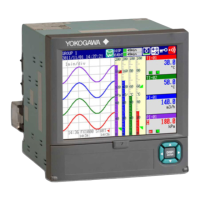1-51
IM 04L42B01-01E
Overview of Functions
1
ReportFunction
This function is used to create hourly, daily, weekly, and monthly reports.
• ReportDataTypes
You can select from four types among maximum value, minimum value, average
value, sum value, and instantaneous value. The maximum, minimum, average, and
sum values are calculated for each scan interval.
• ReportType
Type Description
Hourly report Creates report data every hour on the hour for the previous one hour.
Daily report Creates report data every day at a specified time for the previous one day.
Weekly report Creates report data every week at a specified time at a specified day of
the week for the previous one week.
Monthly report Creates report data every month at a specified time at a specified day for
the previous one month.
• CombinationsofReportsThatCanBeCreated
You can select from hourly reports only, daily reports only, hourly and daily reports,
daily and weekly reports, and daily and monthly reports.
• SourceChannels
You can select from measurement channels, computation channels, and external input
channels. The report data are not created for channels that are set to Skip or Off.
Model NumberofReportChannels
DX2004 and DX2008 12
DX2010, DX2020, DX2030, DX2040, and DX2048 60
• UnitofSumComputation
In the sum computation, data are summed over the scan interval. However, for flow
values that have units /s, /min, /h, or /day a simple summation results in the actual
value not matching the computed result, because the scan interval and the unit of the
input values are different. In such cases, set the sum scale to match the unit of the
input value. In effect, the sum value with the same unit as that of the input value is
calculated.
For example, if the scan interval is 2 s, and the input value is 100 m
3
/min, a simple
summation would add 100 every 2 s resulting in 3000 after one minute. However, if
the sum scale is set to /min, then 2 s/60 s is multiplied every scan interval before the
value is added giving a result that has an m
3
/min unit.
The following converting equations are used to compute the sum. The unit of the scan
interval is seconds.
Off: Σ(measureddataeveryscaninterval)
/s: Σ(measureddataeveryscaninterval)×scaninterval
/min: Σ(measureddataeveryscaninterval)×scaninterval/60
/h: Σ(measureddataeveryscaninterval)×scaninterval/3600
/day: Σ(measureddataeveryscaninterval)×scaninterval/86400
• DisplayingtheReportData
You can display the report data using keys.
For the operating procedure, see section 4.5.
• SavingtheReportData
See section 1.4, “Data Storage Function.”
• NumericDisplayandRecording
The numeric range of the report data is from –9999999 to 99999999 excluding the
decimal point (except –3.4E+38 to 3.4E+38 for sum values).
For the data handling of special cases, see “Special Data Handling” in this section.
For details on the report file format, see appendix 3.
1.8ComputationandReportFunction(/M1and/PM1Options)

